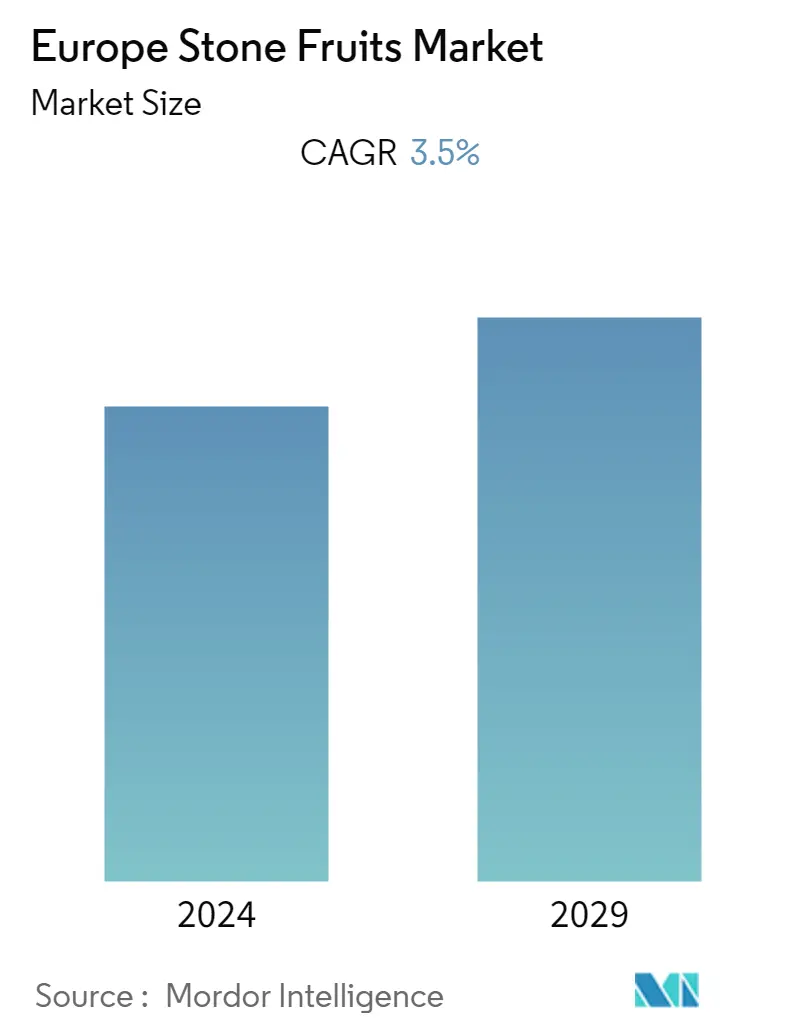Market Size of Europe Stone Fruits Industry

| Study Period | 2019 - 2029 |
| Base Year For Estimation | 2023 |
| Forecast Data Period | 2024 - 2029 |
| Historical Data Period | 2019 - 2022 |
| CAGR | 3.50 % |
Europe Stone Fruits Market Analysis
Europe Stone Fruits Market is projected to grow at a CAGR of 3.5% during the forecast period (2020-2025).
- The rise in health awareness and change in consumer eating habits has stimulated the demand for fresh fruits such as stone fruits within the region. The regional trade supported by high domestic production is promoting the market growth for these fruits.
- Germany, Italy, France, and Spain are some of the attractive markets for Stone fruits within Europe. The favorable climatic conditions supported by cooperative government policies are some of the factors promoting the market growth for stone fruits during the forecast period.
Europe Stone Fruits Industry Segmentation
For the purpose of this report, Apricots, Kiwis, Nectarines, Peaches, and Plums which all belong to the genus prunes are considered as stone fruit. They are also known as drupes, which refer to a fleshy fruit with a hard inner layer, or stone, that surrounds the seed.
| Fruit type | |
| Peaches | |
| Nectarines | |
| Apricots | |
| Plums | |
| Kiwis |
| By Geography | |||||||
| |||||||
| |||||||
| |||||||
| |||||||
| |||||||
| |||||||
| |||||||
| |||||||
| |||||||
| |||||||
|
Europe Stone Fruits Market Size Summary
The Europe stone fruit market is experiencing a positive growth trajectory, driven by increasing health awareness and evolving consumer eating habits that favor fresh produce. This trend is bolstered by robust domestic production and regional trade, particularly in countries like Germany, Italy, France, and Spain, which are key markets for stone fruits. The region's favorable climatic conditions and supportive government policies further enhance the market's expansion prospects. The growing consumer preference for healthy and sustainable food choices is also contributing to the rising demand for stone fruits, with imports reflecting this increased appetite across various European regions.
Spain stands out as a leading producer of stone fruits in Europe, with significant cultivation of apricots, cherries, peaches, and nectarines. The country's strategic initiatives, such as the "Plan for the improvement of the stone fruit sector," have fostered regional production, particularly in provinces like Murcia, Valencia, Aragon, and Catalonia. This has positioned Spain as a key exporter to other European countries, including Germany, the United Kingdom, the Netherlands, and Poland. The combination of high domestic production and favorable policies is expected to sustain the growth of the stone fruit market in Europe over the forecast period.
Europe Stone Fruits Market Size - Table of Contents
-
1. MARKET DYNAMICS
-
1.1 Market Overview
-
1.2 Market Drivers
-
1.3 Market Restraints
-
1.4 Value Chain Analysis
-
-
2. MARKET SEGMENTATION
-
2.1 Fruit type
-
2.1.1 Peaches
-
2.1.2 Nectarines
-
2.1.3 Apricots
-
2.1.4 Plums
-
2.1.5 Kiwis
-
-
2.2 By Geography
-
2.2.1 Italy
-
2.2.1.1 Production Analysis
-
2.2.1.2 Consumption Analysis and Market Size
-
2.2.1.3 Import Market Analysis (Volume and Value)
-
2.2.1.4 Export Market Analysis (Volume and Value)
-
2.2.1.5 Price Trend Analysis
-
-
2.2.2 France
-
2.2.2.1 Production Analysis
-
2.2.2.2 Consumption Analysis and Market Size
-
2.2.2.3 Import Market Analysis (Volume and Value)
-
2.2.2.4 Export Market Analysis (Volume and Value)
-
2.2.2.5 Price Trend Analysis
-
-
2.2.3 Spain
-
2.2.3.1 Production Analysis
-
2.2.3.2 Consumption Analysis and Market Size
-
2.2.3.3 Import Market Analysis (Volume and Value)
-
2.2.3.4 Export Market Analysis (Volume and Value)
-
2.2.3.5 Price Trend Analysis
-
-
2.2.4 Hungary
-
2.2.4.1 Production Analysis
-
2.2.4.2 Consumption Analysis and Market Size
-
2.2.4.3 Import Market Analysis (Volume and Value)
-
2.2.4.4 Export Market Analysis (Volume and Value)
-
2.2.4.5 Price Trend Analysis
-
-
2.2.5 Greece
-
2.2.5.1 Production Analysis
-
2.2.5.2 Consumption Analysis and Market Size
-
2.2.5.3 Import Market Analysis (Volume and Value)
-
2.2.5.4 Export Market Analysis (Volume and Value)
-
2.2.5.5 Price Trend Analysis
-
-
2.2.6 Romania
-
2.2.6.1 Production Analysis
-
2.2.6.2 Consumption Analysis and Market Size
-
2.2.6.3 Import Market Analysis (Volume and Value)
-
2.2.6.4 Export Market Analysis (Volume and Value)
-
2.2.6.5 Price Trend Analysis
-
-
2.2.7 Poland
-
2.2.7.1 Production Analysis
-
2.2.7.2 Consumption Analysis and Market Size
-
2.2.7.3 Import Market Analysis (Volume and Value)
-
2.2.7.4 Export Market Analysis (Volume and Value)
-
2.2.7.5 Price Trend Analysis
-
-
2.2.8 Germany
-
2.2.8.1 Production Analysis
-
2.2.8.2 Consumption Analysis and Market Size
-
2.2.8.3 Import Market Analysis (Volume and Value)
-
2.2.8.4 Export Market Analysis (Volume and Value)
-
2.2.8.5 Price Trend Analysis
-
-
2.2.9 Austria
-
2.2.9.1 Production Analysis
-
2.2.9.2 Consumption Analysis and Market Size
-
2.2.9.3 Import Market Analysis (Volume and Value)
-
2.2.9.4 Export Market Analysis (Volume and Value)
-
2.2.9.5 Price Trend Analysis
-
-
2.2.10 Portugal
-
2.2.10.1 Production Analysis
-
2.2.10.2 Consumption Analysis and Market Size
-
2.2.10.3 Import Market Analysis (Volume and Value)
-
2.2.10.4 Export Market Analysis (Volume and Value)
-
2.2.10.5 Price Trend Analysis
-
-
2.2.11 Rest of Europe
-
2.2.11.1 Production Analysis
-
2.2.11.2 Consumption Analysis and Market Size
-
2.2.11.3 Import Market Analysis (Volume and Value)
-
2.2.11.4 Export Market Analysis (Volume and Value)
-
2.2.11.5 Price Trend Analysis
-
-
-
Europe Stone Fruits Market Size FAQs
What is the current Europe Stone Fruits Market size?
The Europe Stone Fruits Market is projected to register a CAGR of 3.5% during the forecast period (2024-2029)
What years does this Europe Stone Fruits Market cover?
The report covers the Europe Stone Fruits Market historical market size for years: 2019, 2020, 2021, 2022 and 2023. The report also forecasts the Europe Stone Fruits Market size for years: 2024, 2025, 2026, 2027, 2028 and 2029.

